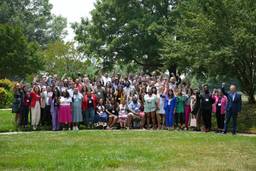The big news out of Toronto, where 26,000 delegates met for the biennial AIDS conference in mid-August, was not the work of tens of thousands of activists, social workers, doctors and nurses who continue to challenge governments and serve and treat AIDS patients. Nor was it that 75 percent of those living (and dying) with HIV still have no access to life-saving treatment, or that indigenous art forms are now being used to educate youth across Asia and Africa about sexual health.
No, on this sad 25th anniversary of AIDS, the media focused on the charity of Bill and Melinda Gates and the rise of Bill Clinton as self-proclaimed world AIDS czar. No wonder Canada’s new conservative prime minister, Stephen Harper, was a no-show. Who could compete with that kind of star power? (Though it didn’t stop Richard Gere or Alicia Keyes from making cameos.)
This celebrity diversion was perfectly fine with the IAS (the International AIDS Society), which puts on this convention with generous assistance from the pharmaceutical industry. However, it frustrated many of the activists, advocates and people with HIV who came to plead for concrete political action and speedier access to anti-retroviral drugs.
These international conferences have always focused disproportionately on biomedical science, rather than on challenging the social structures and cultural attitudes that perpetuate the spread of HIV. Unfortunately, the Toronto conference did little to address this growing divide, physically separating the conference into halls devoted to scientific meetings, stalls to promote the products of drug companies and the large international organizations, and – as a sideshow – an area called the Global Village for the smaller community organizations run by HIV-positive activists, NGOs and various at-risk communities.
While the Gateses, the former president and their new foundations have unquestionably brought more awareness and funding, their speeches were just more of the same rhetoric. “[Donors] should come with the understanding that they don’t know what’s going on and they need to be guided by those with HIV, civil society, and by governmental officials who know more than they do,” said Sipho Mthathi, of South Africa’s Treatment Action Campaign, an AIDS organization run by and for people with HIV. “They must be part of the solutions [but] not dictate them.”
Gregg Gonsalves, formerly with Gay Men’s Health CRISIS and now with AIDS and Rights Alliance for Southern Africa, echoed those sentiments. “President Clinton is good at feeling our pain, he can talk the talk, but we really need governments to act.”
Activists and advocates have been saying for years that the fight against AIDS must be broadened. A comprehensive public health response must involve more than medicine or the hope of a vaccine, it must include real political, economic and social justice.
But instead of real solutions, countries routinely get empty pledges from the international community. The UN’s Global Fund to collectively combat TB, malaria and AIDS still lacks the funds wealthy nations agreed to donate five years ago. President Bush’s PEPFAR (President’s Emergency Program For AIDS Relief) has barely reached the people it pledged to treat. The hope for a vaccine – the silver bullet biomedical science has pinned its hopes on – remains, as it has for the last several conferences, 10 years away. Microbicides, which also generated a lot of discussion in Toronto, still have a long way to go before people can use them to protect themselves from infection.
Gonsalves lashed out at the “vast AIDS infrastructure” and the conference organizers, who he called “largely unaccountable, self-justifying, and pursuing organizational survival and expansion.” The theme of the conference was “Time To Deliver,” yet it refused to question governments such as the United States, Russia, China and South Africa, which willfully ignore the rights of prisoners to receive treatment and obstruct the work of activists and NGOs. Gonslaves also noted that governments could demand more of the drug companies that bankroll such conferences even as they lobby for trade agreements and laws designed to slow access and assure higher profits. He suggests that the conference shift its emphasis from imposing top-down technical solutions to promoting indigenous institutions to counteract the pandemic.
“Unless we start looking at the factors, the root causes that drive health disparities within our communities, we will be always treating one illness, while the patient dies of another,” he says.
Several studies presented at the conference supported this broader approach. One study linked tuberculosis’ continued rise across parts of Africa and Asia to deteriorating public health conditions. And new strains of TB that are drug-resistant have been discovered in parts of Africa. TB remains by far the leading cause of death for people with HIV in much of the continent. Another study by the World Food Program, presented by AIDS physician Paul Farmer, found that six out of 10 HIV-positive patients died while in treatment due to lack of food and poor diets. Without basic nutrients, those taking anti-retroviral drugs can’t absorb the medication or fight opportunistic infections.
Again and again, conference-goers heard what advocates on the ground having been saying for some time: Young woman are increasingly the most vulnerable because of gender inequality, poverty and physiology; intravenous drug users are driving epidemics in Asia, Central Europe and Western countries due to governmental stubbornness and sheer public health ignorance; prison populations continue to be ignored and thus have become breeding grounds for the spread of HIV and TB (the United States has a serious HIV epidemic among those incarcerated); and gay, bisexual and transgender men are seriously underserved in many countries, including the United States, where nearly 50 percent of African American gay and bisexual men are infected.
South African activists were particularly disappointed that the conference has lost the authority to hold governments, institutions and multinational companies more accountable for their incompetence or lack of action. South Africans are suffering from a government that still denies the reality of HIV as the cause of death for the nearly 800 people who die each day in that country. Amazingly, South Africa’s health minister, Manto Tshabalala Msimang, continues to suggest that home remedies such as garlic and lemon are viable alternatives to anti-retroviral treatments.
There was some good news. Drug access has been scaled up in parts of Africa. And the drug Niviraprine continues to show great success in halting the transmission of the virus between an infected mother and child – that is, when women don’t fear learning of their status and clinics provide the treatment. New drugs were announced that are effective against drug-resistant strains, as well as others that respond to the HIV virus in novel ways, such as entry inhibitors and integrase inhibitors. Extended release formations are now being tested that will allow patients to take these new drugs and others only once a week. But the question looms: Will each new generation of drugs require fights between activists and drug companies over availability in developing countries?
And then there was the controversy about the studies showing that male circumcision appears to reduce infection dramatically. Studies in Kenya and South Africa found dramatic results in controlled groups of men who volunteered to be circumcised; in fact, the difference in infection rates between those circumcised and those who weren’t was so high that the one study was halted to offer the uncircumcised the option for the procedure. However, many social scientists and activists, particularly from Africa, questioned using such drastic measures – which would disrupt rituals of deep cultural significance – as a substitute for other methods of prevention.
After a quarter-century, we have learned a lot about HIV and AIDS and the forces that perpetuate this pandemic. AIDS has opened our eyes to the importance of not only state and national public health policy, but international coordination in disease prevention and education. We have learned, too, how important it is for governments to enact policies and laws to assure the rights and health of all citizens; neglecting the health of those on the margins not only breeds disease but destroys economies and family structures. We have also learned that moral prescriptions and punitive measures do little to prevent this disease. We now know that when countries develop comprehensive programs to educate and care for all of their citizens, as Brazil, Thailand and Senegal have done, they can contain this virus.
What we still unfortunately have not learned is how to see this pandemic through the eyes of the people who live with it and work inside it. The tragedy of AIDS is not only that it already has taken the lives of more than 40 million people, and will take many millions more. It’s also that all too many believe that fear, self-righteousness, greed and mere charity are rational and honorable responses to human suffering.

I hope you found this article important. Before you leave, I want to ask you to consider supporting our work with a donation. In These Times needs readers like you to help sustain our mission. We don’t depend on—or want—corporate advertising or deep-pocketed billionaires to fund our journalism. We’re supported by you, the reader, so we can focus on covering the issues that matter most to the progressive movement without fear or compromise.
Our work isn’t hidden behind a paywall because of people like you who support our journalism. We want to keep it that way. If you value the work we do and the movements we cover, please consider donating to In These Times.




